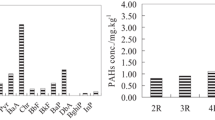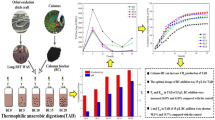Abstract
With the increasing use of municipal solid waste incineration (MSWI) and more stringent limits on landfilling of organic waste, more MSWI bottom ash is being landfilled, and the proportion of inorganic wastes in landfills is increasing, causing the increased Ca concentrations in landfill leachate. In this research, the inhibition effect of Ca concentration on the anaerobic treatment of landfill leachate was studied using a biochemical methane potential experiment. Slight inhibition of methane production occurred when the addition of Ca concentration was less than 2000 mg/L. When the addition of Ca concentration was between 6000 and 8000 mg/L, methane production was significantly reduced (to 29.4–34.8 % of that produced by the BLK reactor), and the lag phase was increased from 8.55 to 16.32 d. Moreover, when the dosage of Ca concentration increased from zero to 8000 mg/L, reductions in solution Ca concentration increased from 929 to 2611 mg/L, and the proportion of Ca in the residual sludge increased from 22.58 to 46.87 %. Based on the results, when the dosage of Ca concentration was less than 4000 mg/L, the formation of Ca precipitates on the surface of sludge appeared to prevent mass transfer and was the dominant reason for the reduction in methane production and sludge biomass. At higher Ca concentrations (6000–8000 mg/L), the severe inhibition of methane production appeared to be caused by the toxic effect of highly concentrated Ca on sludge as well as mass transfer blockage.





Similar content being viewed by others
Abbreviations
- BLK:
-
blank
- BMP:
-
biochemical methane potential
- COD:
-
chemical oxygen demand
- EC:
-
electrical conductivity
- IC:
-
inorganic carbon
- IE:
-
inhibition effect
- MSW:
-
municipal solid waste
- MSWIBA:
-
municipal solid waste bottom ash
- TOC:
-
total organic carbon
- TS:
-
total solid
- UASB:
-
up-flow anaerobic sludge bioreactor
- VFA:
-
volatile fatty acid
- XRD:
-
x-ray diffraction
References
Ahn JH, Do TH, Kim SD, Hwang S (2006) The effect of calcium on the anaerobic digestion treating swine wastewater. Biochem Eng J 30:33–38. doi:10.1016/j.bej.2006.01.014
AHPA (American Public Health Association), American Water Works Association & Water Environment Federation (1998) Standard methods for the examination of water and wastewater, 20th edn. AHPA (American Public Health Association), American Water Works Association & Water Environment Federation, Washington
Angelidaki I, Alves M, Bolzonella D et al (2009) Defining the biomethane potential (BMP) of solid organic wastes and energy crops: a proposed protocol for batch assays. Water Sci Technol 59:927–934. doi:10.2166/wst.2009.040
Barlaz MA, Milke MW, Ham RK (1987) Gas production parameters in sanitary landfill simulators. Waste Manag Res 5:27–39. doi:10.1016/0734-242X(87)90032-2
Dang Y, Zhang R, Wu J, Qiu B et al (2014) Calcium effect on anaerobic biological treatment of fresh leachate with extreme high calcium concentration. Int Biodeter Biodegr 95:76–83. doi:10.1016/j.ibiod.2014.05.016
Hulshoff PLW, de Zeeuw WJ, Velzeboer CTM, Lettinga G (1983) Granulation in UASB reactors. Water Sci Technol 15:291–304
Jeison D, del Rio A, van Lier JB (2008) Impact of high saline wastewaters on anaerobic granular sludge functionalities. Water Sci Technol 57:815–819. doi:10.2166/wst.2008.098
Kjeldsen P, Barlaz MA, Rooker AP, Baun A, Ledin A, Christensen TH (2002) Present and long-term composition of MSW landfill leachate: a review. Crit Rev Environ Sci Technol 32:297–336. doi:10.1080/10643380290813462
Kugelman IJ, McCarty PL (1965) Cation toxicity and stimulation in anaerobic waste treatment. J Water Pollut Control Fed 37:97–116
Kurniawan TA, Lo WH, Chan G, Sillanpää MET (2010) Biological process for treatment of landfill leachate. J Environ Monit 12:2032–2047. doi:10.1039/c0em00076k
Li WB, Yao J, Malik Z, Zhou GD et al (2014) Impact of MSWI bottom ash co-disposed with MSW on landfill stabilization with different operational modes. Biomed Res Int. doi:10.1155/2014/167197
Liu JY (2011) The effect of calcium on the treatment of fresh leachate in an expanded granular sludge bed bioreactor. Bioresour Technol 102:5466–5472. doi:10.1016/j.biortech.2010.11.056
Lo HM, Liao YL (2007) The metal-leaching and acid-neutralizing capacity of MSW incinerator ash co-disposed with MSW in landfill sites. J Hazard Mater 142:512–519. doi:10.1016/j.jhazmat.2006.08.054
Meima JA, Comans RNJ (1997) Geochemical modeling of weathering reactions in municipal solid waste incinerator bottom ash. Environ Sci Technol 31:1269–1276. doi:10.1021/es9603158
Onodera T, Sase S, Choersai P et al (2013) Development of a treatment system for molasses wastewater: the effects of cation inhibition on the anaerobic degradation process. Bioresour Technol 131:295–302. doi:10.1016/j.biortech.2013.12.126
Van Langerak EPA, Gonzalez GG, Van Aelst A et al (1988) Effects of high calcium concentrations on the development of methanogenic sludge in upflow anaerobic sludge bed (UASB) reactor. Water Res 32:1255–1263. doi:10.1016/S0043-1354(97)00335-7
Xia Y, Phoungthong K, Zhang H et al. (2013) Clogging of leachate collection system in a MSW landfill accepting incineration residues. In: Proceedings of the Fourteenth International Waste Management and Landfill Symposium, Cagliari, Italy, 84
Yu HQ, Tay JH, Fang HPH (2001) The roles of calcium in sludge granulation during UASB reactor start-up. Water Res 35:1052–1060. doi:10.1016/S0043-1354(00)00345-6
Zhang DQ, Tan SK, Gersberg RM (2010) Municipal solid waste management in China: status, problems and challenges. J Environ Manage 91:1623–1633. doi:10.1016/j.jenvman.2010.03.012
Zwietering MH, Jongenburger I, Rombouts FM (1990) Modeling of the bacterial growth curve. Appl Environ Microbiol 56:1875–1881
Acknowledgments
This study was financially supported by the National Basic Research Program of China (973 program, no. 2011CB201500), the National Natural Science Foundation of China (no. 21277096), and the Collaborative Innovation Center for Regional Environmental Quality.
Author information
Authors and Affiliations
Corresponding author
Additional information
Responsible editor: Gerald Thouand
Highlights
• Ca inhibition on anaerobic treatment of MSW leachate was investigated.
• Severe inhibition of methane production occurred at Ca concentrations >6000 mg/L.
• Ca in residual granular sludge increased as leachate Ca concentration increased.
• Hypotheses for inhibition mechanisms were developed.
Rights and permissions
About this article
Cite this article
Xia, Y., He, PJ., Pu, HX. et al. Inhibition effects of high calcium concentration on anaerobic biological treatment of MSW leachate. Environ Sci Pollut Res 23, 7942–7948 (2016). https://doi.org/10.1007/s11356-016-6052-3
Received:
Accepted:
Published:
Issue Date:
DOI: https://doi.org/10.1007/s11356-016-6052-3




